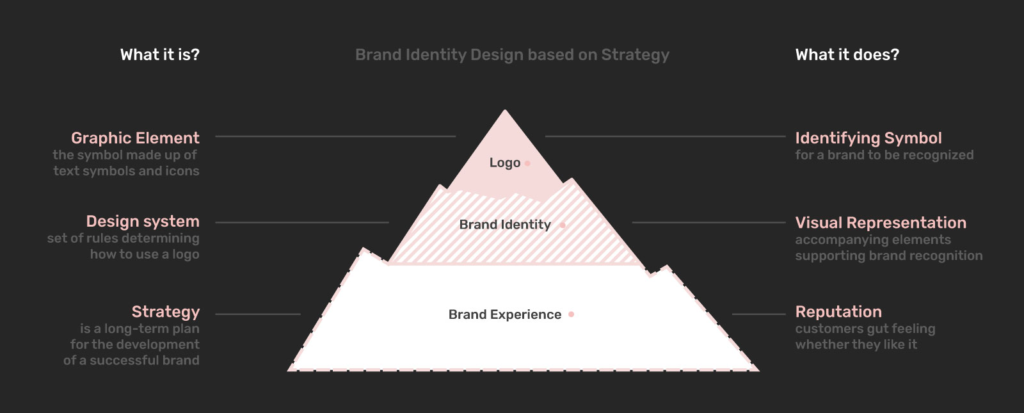Branding is one of the most important aspects of brand management for any business, but it is often overlooked. It is the foundation of a successful business and can make all the difference between success and failure in today’s competitive market.
Branding goes beyond just creating a logo or giving your company an identity. It is about defining the customer experience and communicating your message. It can be used to shape how potential customers perceive your brand valuation your business, as well as improving customer loyalty, increasing customer retention, and creating a powerful emotional connection between your business and its customers.
Through this article, we will discuss what branding is, is branding important, why it is important, some branding tips and how you can use it to create a compelling brand identity that will help grow your business.
Definition of Branding and Why It’s Important
Branding is more than just a logo; it’s the overall identity and value of a company or product. It encompasses logos, color palettes, fonts, messaging—the entire esthetic behind brand value of an organization.
On a deeper level, it is the way in which a company invest in its relationship with customers or potential customers. It involves communicating messages to build trust and loyalty between the brand and the its customer base. Branding helps to differentiate your brand from competitors and establish a lasting impression on the customer’s mind by creating an emotional connection with them.
When done well, brands can leverage their positioning to gain maximum visibility within their market and create higher brand recognition. It can also help increase sales, loyalty and ultimately boosts profits for personal brands too. That’s a great example of why it’s important to focus on understanding your target customer as well as crafting a unique message that resonates with them so that you can stand out from the competition.
Benefits of Building A Strong Brand

Building a strong brand can give your business a competitive edge and set you apart from your competitors. It can also help to create an emotional connection with your customers and build loyalty. Here are some of the key benefits of building a strong brand:
- Credibility & Trust: A well-crafted, recognizable brand will give customers confidence in your products and services because they trust the brand.
- Increased Visibility: With strong branding, you’re creating a unique identity and presence that can help increase sales, as customers become more familiar with and loyal to your brand over time.
- Targeted Marketing: By understanding what makes your brand unique, you can focus on delivering more targeted marketing campaigns that cater to specific customer needs.
- Attracts New Customers: A powerful brand should attract new customers who are interested in the values that your company stands for—such as innovation or environmental sustainability.
In short, building a powerful brand is key for any successful business in today’s competitive marketplace. It enhances credibility and trust, further brand loyalty and allows you to target marketing campaigns with greater precision—all boosting the chances of new customer acquisition in the process.
Read more:
How to Build a Strong Brand Identity

Building a strong brand identity is essential if you want to stand out among the competition. Here’s what you should consider when constructing your new brand identity:
A Unique Logo
Your logo is the most visible part of your brand – it should be unique, recognizable, and memorable. Investing in a professional designer for your logo can help you create an eye-catching brand design that makes your business stand out from the crowd.
Consistent Brand Messaging
Your messaging should be consistent across all platforms – from website copy to social media posts. This will help create a cohesive and recognizable voice for your company that resonates with customers.
Quality Content
Creating quality content is key to building trust with potential customers and creating a connection with them. It doesn’t matter if you’re creating blog posts, podcasts or videos; investing in quality content will help make sure that your message resonates with customers and they form an emotional connection with your brand.
Brand Strategy Guide

When it comes to creating a powerful and impactful brand, it is important to have a strong brand strategy guide. A brand strategy guide serves as a blueprint for how you plan to market your products and services. It outlines the core values and key messaging behind your brand’s values, as well as your target audience. It also includes plans for creating content, promotional materials, advertising campaigns, social media strategies, and more.
Having a clear and concise brand strategy guide helps to ensure that everything that your company produces is consistent with the overall vision statement mission of your business. In other words, all of the pieces of your puzzle fit together to create one cohesive story that resonates with your chosen audience.
Your brand strategy guide can include any of the following items:
- A statement explaining what your company stands for
- A brief overview of who you are targeting
- A description of what makes you different from competitors
- An explanation about the values that drive your business decisions
- A plan for how you will engage customers on social media platforms
- Ideas for content marketing campaigns and initiatives
- Strategies for leveraging partnerships with influencers in related industries
- Benchmarks for measuring success in all areas of marketing efforts
Key Elements of Branding
Branding can be a difficult concept to define, but it generally involves multi-faceted techniques used to create an effective and lasting brand with positive perception and impression. Here are the key elements of successful branding:
Unique Identity
Creating a unique visual design that’s instantly recognizable—like Nike’s trademark swoosh, for example—is one of the most essential elements to branding. Whether it’s through your company logo brand branding, website design or product packaging, having a distinctive identity is crucial for standing out from the competition.
Reputation and Values
Your reputation and values will determine how customers perceive you. Establishing trust with consumers is essential in order to be a successful brand in any industry. Make sure that your brand manifesto and business’ values are clear so potential customers know what you stand for.
Consistency
Having consistency across all channels is important when it comes to making sure customers recognize your brand. Using similar visuals and messaging on your website, social media profiles and print materials will help keep people connected with your brand throughout their customer journey.
By utilizing these key elements of branding, companies can ensure they create an effective brand image that communicates their message and sets them apart from the competition.
Maximizing Impact With Clear Messaging
Brand messaging is an important part of the corporate branding process and can make all the difference when it comes to increasing customer loyalty and recognition. Your message should be clear and consistent, as it will act as a distinguishing factor that makes your company stand out from the competition.
Brand messaging can be used in various forms, such as advertising, website content, blog posts, social media posts, and more. It is important to ensure that your brand messaging is consistent across all channels. This way, you will be able to maximize your reach and better engage with your target audience.
Here are a few tips for crafting effective brand messaging:
- Know who you are targeting – this will help you craft messages that resonate with them.
- Keep it short and simple – complex terminology could confuse your customers.
- Be creative – don’t be afraid to use humor or storytelling in your messages.
- Focus on positive aspects of your product or service – this will create an emotional connection with potential customers.
Differentiating Your Brand in the Market

One of the best ways to stand out in a crowded marketplace is to differentiate your brand. In today’s world, consumers are inundated with companies making similar claims, with equivalent or competing products and services. So it’s important for brands to set themselves apart from their competitors by leveraging their unique strengths and attributes.
Brand differentiation can take a variety of forms, from a brand promise of offering unique products or services tailored to specific customer needs, to using visual assets for developing a distinctive visual identity that sets your brand apart from the crowd.
A strong brand identity can help you build credibility, drive customer loyalty and trust, and ultimately increase your sales. Additionally, establishing yourself as a leader in your industry can help you attract top talent to join your team.
Developing a successful branding strategy requires understanding what makes your company different and why customers should choose you over the competition. You also need to be aware of how other brands are positioning themselves in the market — what messages they’re sending and how they’re communicating who they are — so that you can better differentiate yourself.
Finally, it’s important to keep in mind that differentiating your brand takes time, but it will be worth the effort when you are able to establish yourself as a leader in the industry.
Evaluating Brand Performance Over Time
Branding isn’t just about the design of your logo or the launch of a new website; it’s about consistently delivering an experience that resonates with your target audience. To ensure that your brand is on the right track, it’s important to evaluate its performance over time.
You can do this by:
- Keeping track of how people are engaging with your brand online and offline
- Measuring key indicators such as clicks, views, sales and customer feedback
- Analyzing changes in customer sentiment
- Monitoring the performance of campaigns you have launched
By regularly evaluating brand performance, you can assess whether you’re meeting your desired goals and make any necessary adjustments. This allows you to stay ahead of the curve and keep your brand competitive in today’s dynamic marketplace.
Helps customers remember your business
Your branding is there to remind customers of your business, no matter the context. It’s the distinguishing mark customers use to identify your brand recall the service or product you are offering. Not only does it help with new customers, but it also helps to keep current customers engaged.
Branding is a powerful tool that allows you to differentiate yourself from the competition and stand out from other businesses. By creating an image online branding new business that is instantly recognizable, you are sending a strong message about who you are and what your business stands for.
Having a recognizable brand can help build loyalty in customers and leave them with a positive impression of your company. People will start to associate the feelings they have towards your business with your logo or image; if they have a great experience with your product or services then they will associate this feeling with your brand and be more likely to engage in future transactions.
The importance of branding cannot be overstated – it’s something that should be carefully considered by all businesses and organizations, no matter their size or budget. A good brand can help set you apart from competitors and make sure that everyone knows who you are and what you’re all about!
Engaging customers with your brand

Your brand is the essence visual representation of your company that is presented to customers, and it’s important to understand how to engage them with it. Creating a memorable and engaging brand identity makes an indelible impression on customers, inspiring them to gravitate towards your products and services.
Here are some important aspects of complex process of engaging customers with your brand:
- Establish a unique voice: Developing a unique voice for your brand gives you the power to communicate in a personalized manner that resonates with customers.
- Share unique stories: Customers connect with stories more than traditional advertising — share fascinating tales about your brand that help show its human side and provide memorable experiences for customers.
- Take advantage of digital media: Digital media allows you to interact directly with customers, giving them an easy way to get answers quickly while building relationships with them in the process.
- Create a memorable logo: A logo is one of the most essential elements of any successful business — strive to create an iconic design that encapsulates the spirit of your brand.
- Stay consistent across all channels: Making sure your messaging and branding remain consistent across all platforms helps build recognition and trust in your company over time.
By understanding these key branding elements well, you can create an engaging customer experience that effectively communicates the value of your brand and helps ensure customer loyalty for years to come.
Define your unique values, qualities, and benefits
Defining your company culture with unique brand values, qualities, and benefits is the core of the branding process that will set you apart from your competitors and establish trust with your customers.
Your brand should include:
- A mission statement that communicates what your company stands for and how it delivers value to its customers.
- A unique value proposition that clearly articulates what makes your brand different from others in the same market.
- A strong visual identity with a color scheme or logo to help differentiate your brand from competitors and give customers a sense of familiarity when they see it.
- An effective marketing message that makes people remember your brand and drives them to action.
- Quality customer service in order to build loyalty, trust, and repeat business from customers.
These five components are the foundation for creating a strong brand identity that will resonate with existing customers and potential customers alike, as well as add value to every interaction you have with them.
Branding vs. Marketing

Branding and marketing concepts are often used interchangeably, but they’re not the same. While marketing is focused on the promotion of a product or service, branding is bigger than that.
It’s the foundation of your company’s identity and how you want your customers to perceive you – from brand colors to your visuals to messaging, brand voice and more. This broad definition can encompass everything from print collateral to website design, packaging design and even customer service interactions.
At its core, branding is about developing an emotional connection with customers – it’s not just about a logo or color palette. To have an effective brand means understanding who your target audience is, what they need and expect from you, and how they relate to your brand promises, products or services.
Ultimately, when handled correctly, effective branding helps to differentiate your company’s product from its competition so that customers recognize it as unique and come back for more – now that’s what we call success!
How to develop a style guide
You may be familiar with the term ‘branding’, but do you know what a brand’s style guide can mean for your business? A brand storytelling style guide is a set of rules for how your company should present itself, providing you with clear and consistent brand guidelines.
A successful style guide should encompass a range of elements from typography to color, logos employer branding and imagery. These guidelines should be applied to everything from your website to social media content, brochures and business cards.
Developing a style guide helps create a cohesive look that reinforces your brand’s identity. It will also help ensure consistency across all of your communications, from the messages you send out to how you interact with customers. Here is how to develop an effective style guide:
- Establish design principles
- Define color schemes and typography guidelines
- Ensure logos are used consistently
- Create imagery guidelines
- Outline tone and language rules
- Establish processes for creating content
- Monitor implementation
Following these steps will ensure that you have a comprehensive and effective style guide that will help strengthen your company’s brand identity in both internal and external, marketing communications.
What are the 4 steps of branding?
When working for a marketing agency you can do this in some steps: Identify the target group. Position yourself in the market. Defining the character of our company. Pick your logo. Determine the target audiences. Place your products or business. Define the character of our business. Choose an identity and slogan.
What does branding mean in marketing?
Branding helps customers understand how to support a company in the right manner. They effectively produce lasting impressions that help to increase awareness of their products and services.
What is branding and examples?
Brand marketing is the communication of a unique selling proposition that distinguishes products from their competitors. Brand techniques may involve the application of a logo, tagline or slang phrase to promote products or services.
Conclusion
Branding is an essential part of any business’s success. It helps a company stand out from the competition and create an identity that consumers can recognize and establish trust in. It also allows a business to differentiate its product or service and build loyalty with loyal customers. A well-executed branding strategy will enable a business to not only reach its target audience, but also move them to action. Ultimately, having a strong brand and brand recognition is essential to business success, and the right strategy can take a business to new heights.

